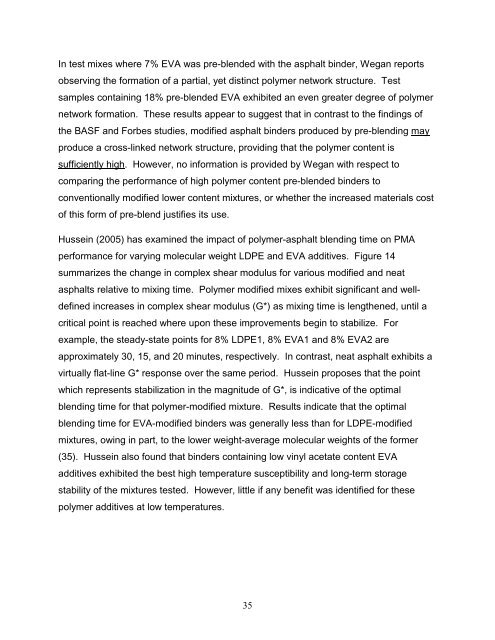Using Polymer Modified Asphalt Emulsions in Surface Treatments A ...
Using Polymer Modified Asphalt Emulsions in Surface Treatments A ...
Using Polymer Modified Asphalt Emulsions in Surface Treatments A ...
You also want an ePaper? Increase the reach of your titles
YUMPU automatically turns print PDFs into web optimized ePapers that Google loves.
In test mixes where 7% EVA was pre-blended with the asphalt b<strong>in</strong>der, Wegan reports<br />
observ<strong>in</strong>g the formation of a partial, yet dist<strong>in</strong>ct polymer network structure. Test<br />
samples conta<strong>in</strong><strong>in</strong>g 18% pre-blended EVA exhibited an even greater degree of polymer<br />
network formation. These results appear to suggest that <strong>in</strong> contrast to the f<strong>in</strong>d<strong>in</strong>gs of<br />
the BASF and Forbes studies, modified asphalt b<strong>in</strong>ders produced by pre-blend<strong>in</strong>g may<br />
produce a cross-l<strong>in</strong>ked network structure, provid<strong>in</strong>g that the polymer content is<br />
sufficiently high. However, no <strong>in</strong>formation is provided by Wegan with respect to<br />
compar<strong>in</strong>g the performance of high polymer content pre-blended b<strong>in</strong>ders to<br />
conventionally modified lower content mixtures, or whether the <strong>in</strong>creased materials cost<br />
of this form of pre-blend justifies its use.<br />
Husse<strong>in</strong> (2005) has exam<strong>in</strong>ed the impact of polymer-asphalt blend<strong>in</strong>g time on PMA<br />
performance for vary<strong>in</strong>g molecular weight LDPE and EVA additives. Figure 14<br />
summarizes the change <strong>in</strong> complex shear modulus for various modified and neat<br />
asphalts relative to mix<strong>in</strong>g time. <strong>Polymer</strong> modified mixes exhibit significant and welldef<strong>in</strong>ed<br />
<strong>in</strong>creases <strong>in</strong> complex shear modulus (G*) as mix<strong>in</strong>g time is lengthened, until a<br />
critical po<strong>in</strong>t is reached where upon these improvements beg<strong>in</strong> to stabilize. For<br />
example, the steady-state po<strong>in</strong>ts for 8% LDPE1, 8% EVA1 and 8% EVA2 are<br />
approximately 30, 15, and 20 m<strong>in</strong>utes, respectively. In contrast, neat asphalt exhibits a<br />
virtually flat-l<strong>in</strong>e G* response over the same period. Husse<strong>in</strong> proposes that the po<strong>in</strong>t<br />
which represents stabilization <strong>in</strong> the magnitude of G*, is <strong>in</strong>dicative of the optimal<br />
blend<strong>in</strong>g time for that polymer-modified mixture. Results <strong>in</strong>dicate that the optimal<br />
blend<strong>in</strong>g time for EVA-modified b<strong>in</strong>ders was generally less than for LDPE-modified<br />
mixtures, ow<strong>in</strong>g <strong>in</strong> part, to the lower weight-average molecular weights of the former<br />
(35). Husse<strong>in</strong> also found that b<strong>in</strong>ders conta<strong>in</strong><strong>in</strong>g low v<strong>in</strong>yl acetate content EVA<br />
additives exhibited the best high temperature susceptibility and long-term storage<br />
stability of the mixtures tested. However, little if any benefit was identified for these<br />
polymer additives at low temperatures.<br />
35
















